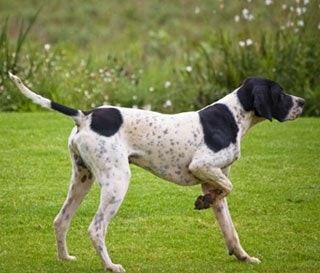Learn about dog breeds
Detailed information & photos on over 190 different breeds
Description
The Pointer is a medium sized dog that is popular now as a family dog. He is also a sporting dog. He is a good sprinter. He holds his head very high and has floppy ears and wide head, and a blunt nose. They have short hair that sheds heavily twice a year. They have excellent sight and are used as sight hounds. They are also good hunting dogs. He is a brave dog, and is good with other dogs when he has been well trained and adequately socialized. They are better with other types of pets than other dogs.
Coat Description
Pointers are water dogs so they have a dense, thick coat of short hair. The hair is designed to be fairly water proof, and has oils to help the waterproofing. The dogs have smooth coats and their fur should not be curly or wavy.
Pointer can be of almost any colour. Dark coated dogs should have a dark nose, and lighter coloured dogs should have a light coloured nose. The dog can either be all one color or can have spots.
History
Several different breeds of dog have come from the Pointer, such as the less commonly known German Wirehaired Pointer. The origin of the Pointer is debated; it is thought that they came from England and were established in the 1500s as hunting dogs. The dog is a genetic descendent of greyhounds, bloodhounds, and foxhounds. They are also descendent of bull terriers. Some people theorize that a Spanish pointer was also bred with these other breeds to create the Pointer. The Pointer was introduced to the United States in the 1800s.
Temperament
Pointers were bred to be hunting dogs for forest expeditions. They readily obey commands from their masters and are loyal and bond to their masters and family. They are very good with children and can tolerate the poking and prodding of children. He should be supervised around small children though, as he could accidentally hurt them. The dog likes to be around its family and does not do well when left alone. The dog is constantly alert and can become restless when he does not get enough exercise. He has a lot of stamina for hunting and exercises events, so he needs a lot of time dedicated to daily exercise. They are good dogs for families and are gentle, loyal and loving. They are good guard dogs. The Pointer can be described as both active and as a couch potato. As long as he has adequate exercise, he can be very happy sitting with you on the couch and watching TV.
Health Problems
The Pointer is fairly healthy, though because he is a larger dog he can develop some hip problems. Never have your Pointer doing a lot of running in the first year of his life before he is physically mature; his can lead to serious hip problems as an adult dog. Other genetic health problems the Pointer has are: hip dysplasia, skin problems, and epilepsy.
Grooming
The Pointer’s short, dense coat is fairly easy to manage. He does need to be rubbed down with a rough cloth at least once a week, but other than that he really doesn’t need very much grooming. You should also use a rubber brush to massage the dog’s skin. This loosens dead hairs. Check the dog’s skin regularly for signs of skin sensitivity problems and for fleas and ticks, especially if you live in a rural area or if the dog is outside often.
Exercise
The Pointer needs about two hours of exercise every day to be healthy and happy. If you do not live in a rural setting but rather in an urban or suburban area, you will need to at the very least take your Pinter out for two long walks each day. You can also have the Pointer run around on the backyard for an extended period of time. This will also help him get the amount of exercise that he needs each day. When the Pointer is young, or elderly, he should not get nearly as much exercise as he needs when he is a mature adult.
Training
The Pointer is very good at following directions, but he is not the most intelligent of breeds and therefore might take a little longer to train than other types of dogs. For the Pointer the most important training is socialization training and housebreaking. Try to be around constantly when you are housebreaking your Pointer, as you need to catch him wetting the floor in order to punish him. DO not punish the dog harshly. He responds better to positive reinforcement than negative reinforcement training methods. Crate training also works well for this breed; just be sure the crate is large enough for the Pointer’s size. Socialization training will help the dog become accustomed to other people and to other dogs, making him a better pet and a friendlier one.
Advertise | Privacy Policy | Terms of Use | Contact Us © Copyright 2004-2024 PupCity.com. All rights reserved.
